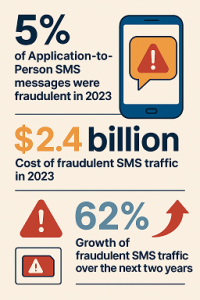Beware of SMS Pumping Fraud: What Small Businesses Need to Know

Cybercriminals are always looking for creative ways to attack businesses and one of the latest scams targeting small companies is called SMS Pumping Fraud.
This growing tactic is designed to cost businesses money, disrupt services, and exploit systems meant for security, like text message verifications.
What is SMS Pumping Fraud?
SMS Pumping attacks target systems that send text message verifications, like one-time passcodes (OTP), password resets, or account confirmations.
Here’s how it works
Attackers use bots or low-cost workers to flood your website or app with fake account sign-ups or password reset requests.
Every fake request triggers a text message (SMS), but instead of going to a real user, it’s sent to a phone number controlled by the attacker.
Behind the scenes, these attackers often work with corrupt telecom providers or shady intermediaries who control how SMS messages are routed.
Instead of delivering the messages to real phones, the fraudsters route them to their own numbers, earning a cut of the fees your business is charged for every text.
What Are the Risks to Small Businesses?
This type of fraud can quickly cause:
Unexpectedly high phone bill costs
System slowdowns or outages from too many verification requests
Abuse of your account creation or password reset processes
Frustration for real customers who can’t access your services
What Can Small Businesses Do to Prevent SMS Pumping Fraud?
The good news is this scam relies on weak security controls and poor monitoring. By making a few changes, you can protect your business and avoid becoming a target.
1. Monitor for Unusual Spikes in SMS or OTP Traffic
Set up alerts to notify you if your systems suddenly start sending an unusual number of SMS messages, especially to locations you don’t normally serve.
Look for red flags like:
-
Hundreds of password reset requests
-
Rapid-fire OTP requests from the same IP address
-
Sudden SMS traffic to unfamiliar countries
2. Require CAPTCHA or Bot Protection Before Sending SMS Messages
Most SMS pumping attacks rely on automation. Stop bots in their tracks by using CAPTCHA or reCAPTCHA on all forms that send verification codes.
Consider adding email verification or behavioral analysis tools for extra protection.
3. Limit the Number of OTP Requests Per User or IP Address
Set reasonable limits on how many times a user or device can request a verification code.
For example:
-
Limit OTP requests to 3-5 per hour
-
Temporarily block or challenge users who exceed this limit
-
Use rate limiting to slow down rapid-fire requests
4. Work With Your SMS Provider for Fraud Protection
Many SMS providers offer tools to help detect and block SMS pumping fraud. Contact your provider and ask about:
-
Fraud monitoring features
-
Geo-blocking high-risk regions
-
Real-time alerts for abnormal SMS usage
-
Filtering out known fraud numbers or SMS pumping routes
Also, check your contract, make sure you’re not being charged for undelivered or fraudulent SMS traffic.
Final Thought
SMS Pumping Fraud isn’t just a problem for big companies, in fact, small businesses are often easier targets because they lack the same protections.
Taking a few simple steps now to secure your SMS systems could save your business thousands of dollars in fraud losses down the road.
Contact us if you feel your security footprint is lacking. We can help.
